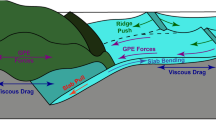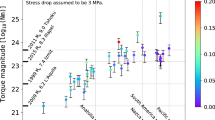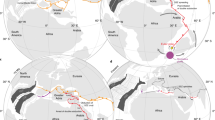Abstract
replying to M. L. Rudolph & S. Zhong Nature 503, 10.1038/nature12792 (2013)
We thank Rudolph and Zhong for their Comment1, which allows us to highlight important aspects of our original Letter2. In particular, they have provided an example of plate motions at 300 million years (Myr) ago (see right column of figure 1 of ref. 1) in which the plate tectonic quadrupole is not representative of plate tectonic divergence patterns (that is, there is no divergence in the middle of their supercontinent, despite a divergent quadrupole there). However, our study2 does not claim that there should be a correspondence between quadrupole locations and the specific locations of plate tectonic divergence—instead we argue that plate tectonic dipole and quadrupole locations are representative of underlying mantle flow only.
Similar content being viewed by others
Main
This 300-Myr example actually demonstrates the utility of our method. To see this, consider mantle flow beneath a supercontinent covering one-third of the globe: mantle upwelling is expected beneath the opposing ocean’s spreading ridges, but mantle downwelling occurs neither opposite to this upwelling (as for dipole flow) nor in bands 90° away (as for quadrupole flow), but instead associates with subduction occurring between these two locations on the supercontinent’s periphery. Return flow from this downwelling should drive upwellings beneath both the supercontinent and the oceanic plates. Indeed, upwelling is expected beneath a supercontinent that will soon disperse3,4.
Thus, we expect strong upwelling beneath the oceanic plates and weaker upwelling beneath the supercontinent; such a flow field is described by a combination of dipole and quadrupole flow fields that partially cancel beneath the supercontinent. This pattern is exactly predicted by the net characteristics (or spherical harmonics) of surface plate motions: the 300-Myr analysis of ref. 1 shows weak divergence within the supercontinent, indicating underlying upwelling. Thus, the lifetime of the two antipodal upwellings in the mantle may extend beyond the 250 Myr that we demonstrated in our original Letter2. More importantly, this analysis1 demonstrates the importance of using only the longest-wavelength components of plate motions to visualize the underlying mantle flow patterns. By including shorter-wavelength spherical harmonic degrees, Rudolph and Zhong have incorporated the influence of regional and local tectonics into their interpretation1; doing this obscures the underlying mantle flow patterns that are only apparent at the longest wavelengths2.
We agree with the Comment1 that quadrupole stability alone does not prove long-term stability of the LLSVP regions, and that additional constraints from “robust observations” are necessary. Indeed, the locations of large igneous provinces and kimberlites have been shown to source from the margins of two antipodal LLSVPs5, and would arise above a cold downwelling on the African side if the degree-1 interpretation of ref. 1 is correct. Furthermore, the 300-Myr plate motion example1 is based on a study6 that does not control for palaeolongitude or true polar wander, so it is unclear how surface features are related to LLSVP locations. Their portrayal of Pangaea as a stable coherent polygon additionally ignores much of the tectonic complexity of that supercontinent’s evolution7. These problems illustrate the importance of using a carefully reconstructed model of past plate motions when attempting to use “net characteristics” to constrain LLSVP stability.
References
Rudolph, M. L. & Zhong, S. Does quadrupole stability imply LLSVP fixity? Nature 503, http://dx.doi.org/10.1038/nature12792 (2013)
Conrad, C. P., Steinberger, B. & Torsvik, T. H. Stability of active mantle upwelling revealed by net characteristics of plate tectonics. Nature 498, 479–482 (2013)
Gurnis, M. Large-scale mantle convection and the aggregation and dispersal of supercontinents. Nature 332, 695–699 (1988)
Lowman, J. P. & Jarvis, G. T. Effects of mantle heat source distribution on supercontinent stability. J. Geophys. Res. 104, 12733–12746 (1999)
Torsvik, T. H., Burke, K., Steinberger, B., Webb, S. C. & Ashwal, L. D. Diamonds sourced by plumes from the core–mantle boundary. Nature 466, 352–355 (2010)
Zhang, N., Zhong, S., Leng, W. & Li, Z.-X. A model for the evolution of the Earth’s mantle structure since the Early Paleozoic. J. Geophys. Res. 115, B06401 (2010)
Torsvik, T. H. et al. Phanerozoic polar wander, paleogeography and dynamics. Earth Sci. Rev. 114, 325–368 (2012)
Author information
Authors and Affiliations
Corresponding author
Rights and permissions
About this article
Cite this article
Conrad, C., Steinberger, B. & Torsvik, T. Conrad et al. reply. Nature 503, E4 (2013). https://doi.org/10.1038/nature12793
Published:
Issue Date:
DOI: https://doi.org/10.1038/nature12793
Comments
By submitting a comment you agree to abide by our Terms and Community Guidelines. If you find something abusive or that does not comply with our terms or guidelines please flag it as inappropriate.



